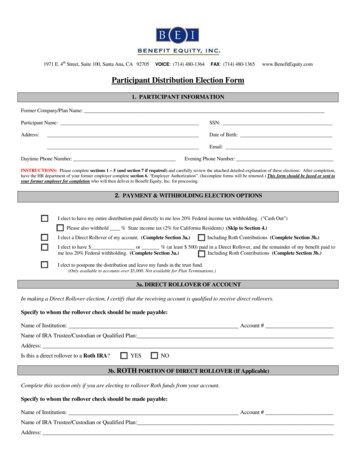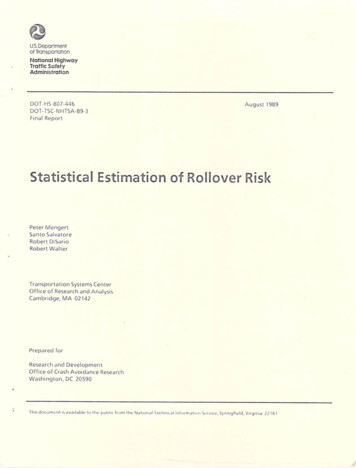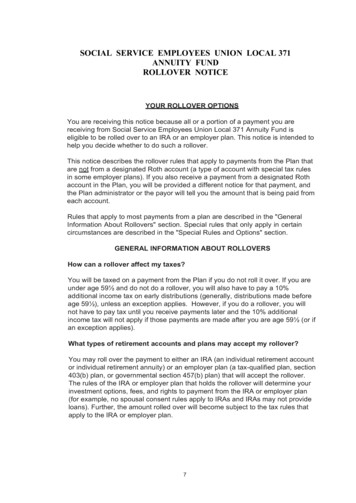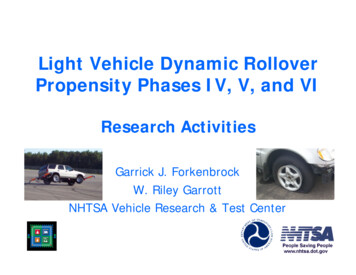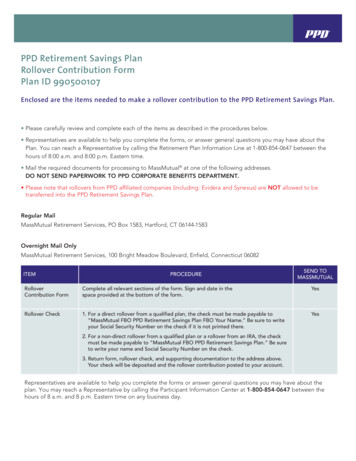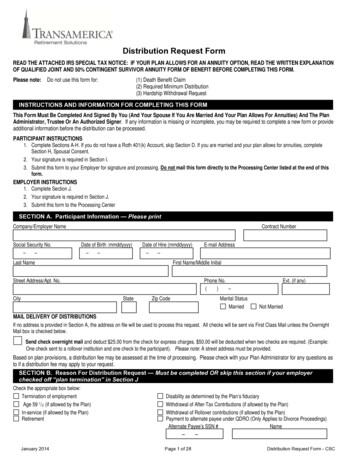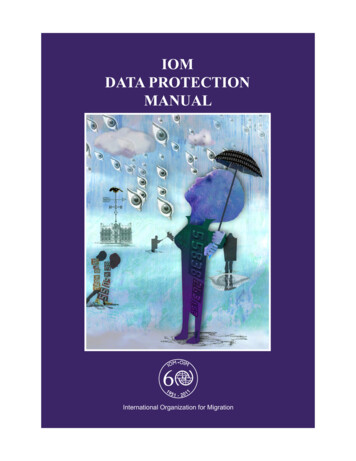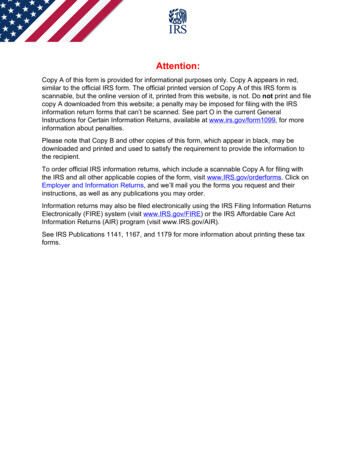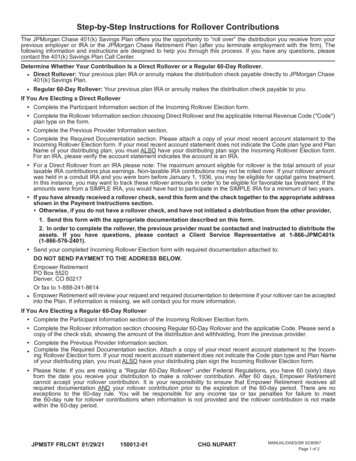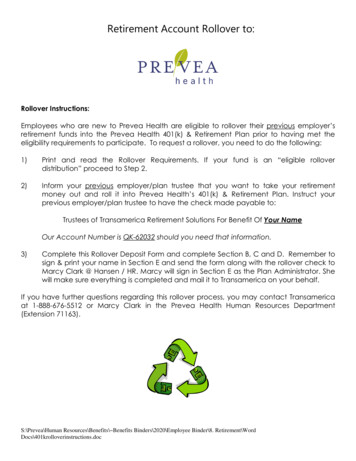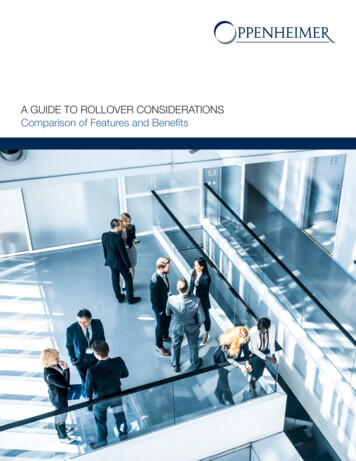
Transcription
A GUIDE TO ROLLOVER CONSIDERATIONSComparison of Features and Benefits
A GUIDE TO ROLLOVER CONSIDERATIONS (COMPARISON OF FEATURES AND BENEFITS)If you are eligible for a rollover, you should carefully consider the features and benefits of your current retirement plan versusa rollover to an IRA. Further, if you work for a new employer with a retirement plan that will accept rollovers from your currentplan, you may wish to consider the features of your new employer’s plan to see if it makes sense to rollover your existingfunds to that new plan. This guide examines different methods and considerations that you should be aware of whenreceiving or rolling over qualified retirement plan distributions.This guide is intended to help you navigate the following features of a rollover:Eligibility for rollover4Requesting your retirement plan distribution4Transferring funds directly to your IRA (“direct” rollover)4If you received funds but did not request a direct rollover4If your retirement plan will distribute more than just cash4Rollover considerations Age 55 provision4 Attainment of age 725 Participants in governmental 457(b) plans5 If you have employer securities in your retirement plan (NUA)5 If your plan contains after-tax contributions5 Rollover/conversion of pretax amounts to a Roth IRA5 Rollovers from Roth 401(k) accounts5 60-day rollover extensions6 Comparison of an IRA vs. an employer’s qualified retirement plan6 Comparison of IRA and qualified plan distribution penalty exceptions7 If you receive assets through a divorce or as an alternate payee (QDRO)7 If you are a beneficiary7
OVERVIEWEmployer-sponsored retirement plans such as 401(k), profit sharing, and other types of qualified retirement plans allow theparticipants in the plan to recognize certain tax benefits while saving for retirement. These retirement plans are subject to lawsand documents that outline plan provisions such as who is eligible and when assets may be distributed from the plan.Plan distributions before age 591/2 are generally subject to income taxes and a potential 10% early withdrawal penalty so it is oftenadvisable to delay a distribution until 591/2. A transaction called a rollover permits you to distribute your retirement plan benefitswhile continuing to defer income tax and the potential penalties otherwise associated with a distribution of retirement assets.In a rollover, you transfer the proceeds of your existing retirement plan into a new retirement plan which may be either anIndividual Retirement Account (IRA) maintained by you or a different retirement plan sponsored by a new employer. Fundstransferred out of your existing plan in this way are not taxable or subject to the 10% penalty. You may also choose torollover the assets to a Roth IRA, which is an account that can provide tax free income. In this case, income tax may be dueon your rollover but the 10% penalty will not apply. Any Roth 401(k) balances you may have must be rolled over to a RothIRA with no tax is due on this type of rollover. If your retirement plan balance contains any other after-tax contributions, youmay also choose to roll those over to a Roth IRA and generally tax is not due unless your rollover contains earnings. Yourplan administrator can provide you with details about the types of contributions of which your retirement plan balance iscomprised.CONSIDERING A ROLLOVER?Start by asking the following: What is my current plan providing? What are my options? How do these options differ?ARE YOU ELIGIBLE FOR A ROLLOVER?To distribute your benefits from a qualified retirement plan, participants generally need to have experienced a “triggering event”(such as retirement or other separation from service) or the plan needs to allow for “in-service” withdrawals. In an in-servicewithdrawal, you are permitted to distribute your assets even if you still work for the employer who sponsors the plan. Somespecific types of withdrawals, such as loans, hardship, or corrective distributions, may be distributed to you while you are stillworking but are not eligible to be rolled over.WHY CONSIDER A ROLLOVER?There are a variety of reasons participants choose to rollover savings from an employer sponsored retirement plan. Makinga rollover can provide a way to use your tax advantaged retirement savings in a more flexible way. Compared to manyemployer-sponsored qualified retirement plans, a self-directed IRA through an Oppenheimer Financial Advisor may investin a large variety of investments such as thousands of stocks, bonds, annuities or mutual funds, and also offers access toinvestment managers that can help guide your investment portfolio.Current Employer’s Qualified PlanNo tax or penalty due.Traditional IRAPenalty may be due.Tax generally due.Personal AccountNo tax or penalty due.Subject to new plan’s restrictions.New Employer’sQualified PlanIn addition to the various investments available in your Oppenheimer retirement account, your Oppenheimer Financial Advisorcan also help you prepare for your retirement years by discussing various financial goals you may have and illustrating retirementsavings and spending toward those goals through a Retirement Outlook illustration or comprehensive financial planning. Theadvice and guidance we provide has helped thousands of people to save, invest, and plan to and through retirement.3
ELIGIBILITY FOR ROLLOVERIn general, most amounts distributed to you from a qualifiedretirement plan will be eligible for rollover to an IRA; however, thereare some exceptions. These include: Loans Hardship withdrawals Removals of excess contributions Required minimum distributions (RMDs) Payments issued by a plan under specific calculation methods,where the payments are expected to be issued for life or over aperiod of 10 or more yearsThe plan administrator of your retirement plan should easily be ableto let you know if your retirement benefits are eligible for rollover.REQUESTING YOUR RETIREMENT PLAN DISTRIBUTIONTo request a distribution from your retirement plan, you will initiatea request with the plan administrator who holds your plan account.For a payment that is eligible for rollover, you will generally begiven the option to have a your assets transferred directly from theplan into an IRA in your name (a “direct” rollover) or to a different(non-IRA) account, for example a direct deposit to a personal bankaccount or a check payable to you or someone else. This secondrollover option allows you a period of up to 60 calendar days todeposit the funds as a rollover to your IRA1 (a “60-day rollover”).If you do not request a direct rollover to an IRA but your payment iseligible to be rolled over, the plan administrator is generally requiredto withhold 20% for federal income tax purposes even if youintend to rollover the funds to an IRA later. By requesting a directrollover from your current retirement plan to an IRA, you avoid themandatory 20% withholding requirement. The example later in thisguide illustrates the options available to you when your distributionis subject to 20% mandatory withholding.No matter which method of rollover you pick, the amount paid fromyour employer’s plan will be reported on Internal Revenue Service(IRS) Form 1099-R. However, how the amount is reported on thisform and whether it is taxable will depend on which option youselect. For distributions that are rolled over as either a direct or 60day rollover, you should expect to receive IRS Form 5498 from yourIRA custodian in the year after the rollover is complete.TRANSFERRING FUNDS DIRECTLY TO YOUR IRA(“DIRECT” ROLLOVER)With a direct rollover, you do not take possession of the funds andyour withdrawal is not subject to mandatory 20% tax withholding.The full amount of your retirement plan withdrawal will be paiddirectly to your IRA either through a check payable directly to yourIRA custodian or through a direct electronic transfer initiated byyour current plan administrator. Often, the plan administrator willsend a direct rollover check to you, but it will be payable to yourIRA and IRA custodian.When you complete a direct rollover, the IRS Form 1099-R youreceive from your plan administrator will note that the withdrawnamount was issued as a payment directly to an IRA, and the IRS willknow that tax and penalties are not due and to expect a Form 5498.IF YOU RECEIVED FUNDS BUT DID NOT REQUEST ADIRECT ROLLOVERIf your distribution is eligible for rollover but the payment you receive isnot a direct rollover, your withdrawal is generally subject to mandatory20% withholding. This means you will receive only 80% of yourwithdrawal amount, with the remaining 20% credited to your federalincome tax return. You then have 60 calendar days (unless you qualifyfor an extension) to deposit up to 100% of your withdrawal amount toyour IRA in order to avoid taxes and potential penalties.If your intent is to rollover 100% of your distribution to an IRA, youwill need to replace the 20% withheld amount out of pocket sinceyou will not receive it back from the IRS until you file your taxes.Any amounts that you do not rollover, including the 20% that waswithheld for taxes, will generally be subject to taxes and possibly a10% premature withdrawal penalty.If a distribution to you is not subject to 20% withholding, unlessit is a distribution of after-tax contributions or is a qualified Roth401(k) distribution, it is likely ineligible for rollover to an IRA or otheremployer retirement plan.If you intend to rollover your retirement plan benefits, you shouldconsider requesting your distribution as a direct rollover in order toavoid the 20% mandatory withholding.IF YOUR RETIREMENT PLAN IS MORE THAN JUST CASHMany participants have mutual funds or other types of securities in theiremployer’s retirement plan. If your retirement plan is invested, mostplan administrators require liquidation of these investments beforecompleting a rollover, although some do not. For this reason, rolloversare generally completed by check or electronic transfer of cash.If your plan investments include any employer securities (such as astock or other security issued by your employer), you should reviewthe Rollover Considerations covered later in this guide on a strategyutilizing the net unrealized appreciation (NUA) of the security.THINGS YOU SHOULD CONSIDER ABOUT A ROLLOVERWhether or not you should complete a rollover may be affectedby factors that should be considered. These potential issues aredescribed below.Age 55 provisionMost distributions from your employer’s retirement plan are subjectto a 10% penalty in addition to being subject to ordinary incometax if they are received prior to when you turn age 59½. There is animportant exception to this penalty. If you separate from service withan employer during or after the calendar year in which you reachage 55, you can take distributions from that employer’s qualifiedretirement plan before age 59½ without incurring the 10% penalty.If you rollover your plan to an IRA, this special provision does notcarry over to the IRA. Thus, participants in retirement plans whomeet this condition for the age 55 exception may wish to wait untilage 59½ to rollover their plan to an IRA.The IRS permits some extensions to the 60-day period. Some recipients, such as non-spouse beneficiaries, may be ineligible and required to complete adirect rollover as opposed to a 60-day rollover.14
If you separate from service before reaching age 55 you are alsonot eligible for this exception even once you reach age 55. In thiscase, you will need to wait until age 59½ to receive penalty-freedistributions from your employer’s retirement plan unless you qualifyfor a different exception.Attainment of Age 72Many types of retirement plans require the participant to beginreceiving minimum amounts from those plans upon reaching age72. These payments are known as Required Minimum Distributions(RMDs). However, if you have reached age 72 and are still working forthe employer that sponsors the retirement plan you may receive anadvantage by leaving your retirement assets in your employer’s retirementplan, since a plan may permit participants who are age 72, less than a5% owner in the company that sponsors the plan, and still working topostpone receiving RMDs until April 1 following the year they retire.Traditional IRAs that receive rollover assets do not permit thispostponement. Once assets are rolled over to an IRA, RMDs mustbegin in the following year based on fair market value of the IRA onDecember 31 of the year the rollover is complete. Only assets thatremain in the plan can continue to qualify for the postponement.However, if you rollover a Roth 401(k) balance, RMDs are notrequired until your beneficiaries inherit your Roth IRA.When considering a rollover to an IRA, you may want to considerthe RMD implications.Participants in governmental 457(b) plansIf you are under age 59½ and participate in a 457(b) plansponsored by a governmental entity, you should consider yourexpected use of your retirement assets before completing arollover. Participants in governmental 457(b) plans are generallyeligible to receive penalty-free distributions beginning at age50. Once these assets are rolled over into an IRA, penalty-freedistributions based on age will not be available until you turn 59½.If you have employer securities in your retirement plan (NUA)Participants that hold investments of securities issued by theiremployer, such as the employer’s stocks or bonds, in their qualifiedretirement plan might want to take advantage of a “net unrealizedappreciation” (NUA) strategy. Using this strategy may reduce yourtax bill, potentially by a significant amount.Under the NUA strategy: You take a lump sum distribution from the plan (meaningthat the full balance is removed from that plan within a singlecalendar year). The employer securities are distributed from the retirement planto a regular investment account and are not rolled over to an IRA. Your remaining retirement plan balance may be issued as arollover to another retirement plan or IRA.Typically, the full value of assets distributed from your retirementplan into a regular investment account would be subject to incometax and potentially a 10% penalty (unless they are later rolled overto another retirement account). However, under NUA, only thetotal cost basis (the price paid for the security) of the distributedemployer securities is subject to income tax. (If you do not qualify fora penalty exception, a 10% penalty will also apply.) The appreciation(in other words, the market value of the security minus the costbasis, or NUA) is not taxed until the employer securities are sold inthe investment account and the appreciation becomes realized.Generally, the appreciation will be taxed at the long term capital gainsrate (0%, 15%, or 20% depending on your overall income level) ifthe investments are sold upon distribution. If they are not sold upondistribution, any additional appreciation above the distributed marketvalue of the securities will be taxed at a long or short term capitalgains rate depending on how long the securities have been held in thetaxable account (if more than 1 year, the long term capital gains rate).The advisability of using the NUA strategy is generally dependenton a number of different factors, such as the amount of theappreciation, the length of time until the investment is used forexpenses, your tax rate, and more. If your qualified retirement planassets include securities of your employer, you should requestOppenheimer’s guide Net Unrealized Appreciation: A Brief Overviewwhich contains more information and examples, and also discusswith your tax advisor. You will have to notify your plan administratorif you wish to distribute employer securities under the NUA option.If your plan contains after-tax contributionsIf your employer retirement plan savings contain after-taxcontributions, you have the opportunity to receive these fundsseparately from any pretax funds. You may either request a taxfree distribution of these proceeds, which you can then invest ina taxable account, roll into a traditional IRA, or perform a tax-freerollover of these funds to a Roth IRA. If you choose to rollover yourafter-tax balance to a traditional IRA, you will no longer be able todistribute the after-tax funds separately.If you have after-tax amounts in any non-Roth IRA, distributionsfrom any of your non-Roth IRAs are taxed on a pro-rata basistaking into consideration all your non-Roth IRAs. For example, ifthe total balance in these IRAs is 100,000 including an after-taxportion of 25,000, a distribution of 10,000 would be consideredas 7,500 of taxable income and 2,500 of tax-free income.After the distribution, your remaining balances would be 67,500pretax and 22,500 after-tax. Future earnings would accumulatetowards the pretax balance, altering the proportion of your taxabledistributions each year. For this reason, it is often advisable toconsider a rollover of your after-tax contribution amounts to a RothIRA for future tax free growth of qualified distributions.Rollover/conversion of pretax amounts to a Roth IRAYou are also able to rollover your pretax qualified retirement planfunds to a Roth IRA. By performing a direct rollover conversion toa Roth IRA, you will not be subject to mandatory 20% withholding.However, any pretax funds directly converted will be subjectto ordinary income tax but not subject to a 10% penalty. If yousubsequently take a distribution from the Roth IRA within 5 yearsof the conversion, you will be subject to a 10% penalty on pre-age59½ withdrawals of the converted amounts from the Roth IRAunless you qualify for an exception.Rollovers from Roth 401(k) accountsFunds in a Roth 401(k), known as a “designated Roth account,”can be rolled over directly into a Roth IRA. However, you musthave held your designated Roth account or Roth IRA for at least5 years in order to receive qualified distributions that are eligiblefor certain tax benefits. If your Roth IRA was already in existencewhen the Roth 401(k) rollover was received, your original RothIRA contribution date will determine the 5-year period. However,if you established the Roth IRA in order to receive the Roth 401(k)rollover, the determination of the 5-year period will be based on theestablishment of the Roth IRA.5
60-day rollover extensionsGenerally, rollovers other than direct rollovers must be completedwithin 60 calendar days to be valid. This 60-day period may beextended in limited circumstances as prescribed by the IRS. Your taxadvisor can provide more information regarding eligible extensions.While IRA account holders are generally limited to one 60-dayrollover per 12 month period, that limitation does not apply to60-day rollovers initiated from an employer-sponsored qualifiedretirement plan.Comparison of an IRA vs. an employer’squalified retirement planThere are many attractive features and benefits of an IRA, andmany reasons a rollover from your employer’s qualified retirementplan may make sense. There are also some reasons you may wishto leave your retirement savings in the plan. The following chartcompares some features and benefits of each to help you makeyour decision.Oppenheimer IRA Rollover May be higher or lower – larger employer plans mayhave lower investment-related fees while smalleremployer plans may have higher fees Plan administration fees may apply Comprehensive or limited advice may be availabledepending on the planVirtually unlimited – generally any stock, bond, ormutual fund, as well as professional investmentmanagement programs and annuities Limited to a short list of funds, unless a brokerageaccount is available Permitted Not permitted Flexible, can occur upon request through a variety ofmethods May be limited in timing options Unless an exception applies, penalty-free withdrawalsare not available until age 59½Penalty-free withdrawals may be available immediatelyif you separated from service during or after the yearyour attain age 55 Required distributions at age 72 (applies to traditionalIRA rollovers) Required distributions at age 72 or retirement,whichever is later (requirements apply) No loans available, but may complete a single 60-dayrollover every 12-month period Distributions do not require spousal consentLoans may be available, and eligible rolloverdistributions may be completed as 60-day rollovers toanother eligible retirement account Distributions generally require spousal consent Designation of a non-spouse beneficiary optionrequires spousal consent Customization is generally limited May be higher or lower – depends on investments andstrategies employed Custodial fees may applyInvestment Advice Comprehensive, personalized strategies and one-onone adviceInvestment Options Tax-Free Qualified CharitableDistributions at age 70 ½DistributionsFeesEmployer Qualified Retirement Plan Designation of a non-spouse beneficiary generallydoes not require spousal consent (special rules mayapply for residents of community property states) Customized beneficiary designations permitted Beneficiaries may not convert an inherited traditionalor rollover IRA to an inherited Roth IRA Your non-spouse beneficiary can rollover/convert to aninherited Roth IRA (tax consequences may apply) Beneficiaries may select from IRS-allowabledistribution options Your beneficiaries may face limited distribution optionsunless they transfer the inheritance to a beneficiary IRA Beneficiary stretch permitted When you rollover your employer-sponsored retirement plan assets, you retain unlimited bankruptcy protection State law determines the protection from creditorsoutside of bankruptcyTax Treatment of Distributionsof Employer Securities(Net Unrealized Appreciation) There is no NUA treatment available Preferential tax treatment is available on the amount ofthe NUAFederal Tax Withholding You may opt out of federal withholding or withhold atyour desired percentage In general, federal withholding is set at a mandatory20%, unless you distribute as a direct rolloverDistribution PenaltyExceptions Specific to Each Qualified higher education expenses Pass through of dividend on employer securities First time homebuyers ( 10,000 lifetime limit) Health insurance premiums paid while unemployedSeparation from service during or after the year youturn 55 (age 50 for public safety employees of a state,or political subdivision of a state, in a governmentaldefined benefit plan) For participants in a governmental 457(b) plan,attainment of age 50 (except for balances fundedthrough a rollover from another type of plan or IRA)Designating BeneficiariesOptions for your BeneficiariesCreditor Protection6Creditors cannot access qualified plan assets, withlimited exceptions
Comparison of IRA and qualified plan penalty exceptionsDistributions of pretax amounts from IRAs and qualified plans aregenerally subject to tax and may be subject to a 10% penalty.However, some exceptions to the 10% penalty differ based onwhether the funds are being distributed from your qualified planversus from your IRA after you complete a rollover.Apply to IRA and qualified plan Attainment of age 59½ Death of IRA owner/participant Substantial disability of IRA owner/participant Substantially equal periodic payments Unreimbursed medical expenses greater than 10% of adjustedgross income 60-day or direct rollover to an IRA or eligible retirement planApply to IRA owners only Qualified higher education expenses First time homebuyers ( 10,000 lifetime limit) Health insurance premiums paid while unemployedproceeds to either your own or a beneficiary IRA or Roth IRA eitheras an indirect rollover within the 60-day period or as a direct rollover.Non-spouse beneficiaries do not have the indirect 60-day rolloveroption. If you are a non-spouse beneficiary and wish to establishan inherited IRA or Roth IRA, you will need to inform the planadministrator of the current plan and you must transfer the fundsdirectly between the plan and IRA as a direct rollover.If you receive distributions as a beneficiary from a qualifiedretirement plan or from an inherited IRA, you are not subject to the10% early withdrawal penalty regardless of your age. In addition,while owners of inherited IRAs cannot convert the assets to a Rothor inherited Roth IRA, a special provision allows beneficiaries of aninherited employer qualified retirement plan to convert the pretaxmoney in a direct rollover conversion to an inherited Roth IRA(paying any applicable taxes). Keep in mind however that inheritedRoth IRAs for a non-spouse are subject to distribution requirementsfor any beneficiaries.For more information on receiving payments from beneficiaryIRAs, ask for Oppenheimer’s guide titled IRA BeneficiaryDistribution Options.Apply to qualified retirement plan participants only Pass through of dividend on employer securities Separation from service during or after the year you turn 55 (age50 for public safety employees of a state, or political subdivisionof a state, in a governmental defined benefit plan) For participants in a governmental 457(b) plan, attainment ofage 50 (except for balances funded through a rollover fromanother type of plan or IRA)Every individual will have different needs and goalsdepending on his or her particular circumstances. It isessential to consult with qualified tax and legal advisorsto formulate an effective strategy for you. Oppenheimeris well positioned to help. Contact your OppenheimerFinancial Advisor for more information!If you receive assets through divorce or as an alternate payeeIf you receive retirement plan assets through a divorce or as analternate payee, they must be awarded under what is known as aQualified Domestic Relations Order (QDRO).If you are the spouse or former spouse of a plan participant, youwill generally have the option to rollover the funds in the mannerdescribed in this brochure. If you choose to receive the assetsfrom the plan as payable to you personally, you will not be subjectto the 10% penalty even if you choose not to rollover the assets.However, the distribution must still generally be included in yourincome for the year and subject to applicable income tax. Shouldyou choose to rollover your distribution to an IRA, you will not oweincome tax until you distribute the funds from your IRA, but if youare under age 59½ you will not be able to receive penalty-freedistributions unless you qualify for an exception.If you are not the participant’s former spouse but receive retirementplan assets through a QDRO, such as a child of a participant,you are not eligible to rollover the assets to an IRA. However, adistribution to you as a non-spouse payee under the QDRO will betaxable to the plan participant.If you are a beneficiaryIf you are a beneficiary of a qualified retirement plan, you have theoption to rollover the proceeds to what is known as an “inherited” or“beneficiary” IRA or Roth IRA after the death of the plan participant.If you are a spouse, you have the additional option to rollover the7
Oppenheimer & Co. Inc. 2020 Oppenheimer & Co. Inc. Transacts Business on All Principal Exchanges and Member SIPC. All Rights Reserved.85 Broad StreetThe information contained herein is general in nature, has been obtained from various sources believed to be reliable and issubject to changes in the Internal Revenue Code, as well as other areas of law. Neither Oppenheimer & Co. Inc. (“Oppenheimer”)nor any of its employees or affiliates provides legal or tax advice. Please contact your legal or tax advisor for specific adviceregarding your circumstances.New York, NY 10004800-620-OPCO 212-668-8000www.opco.comNo part of this brochure may be reproduced in any manner without the written permission of Oppenheimer & Co. Inc.2966879.1
Rollovers from Roth 401(k) accounts 5 60-day rollover extensions 6 Comparison of an IRA vs. an employer's qualified retirement plan 6 Comparison of IRA and qualified plan distribution penalty exceptions 7 If you receive assets through a divorce or as an alternate payee (QDRO) 7 If you are a beneficiary 7
